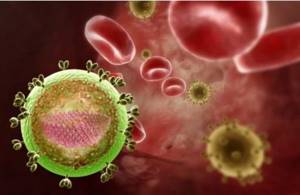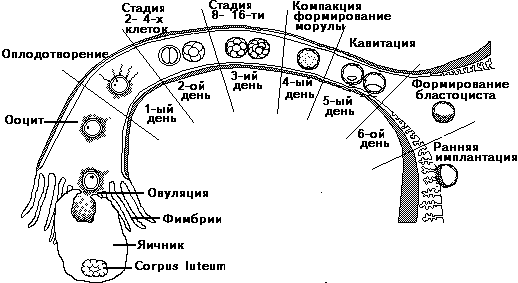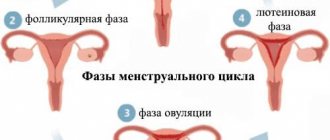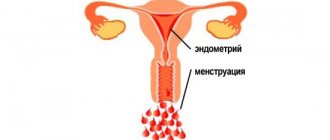Menstruation, or menstruation, is a process associated with the rejection of a layer of the mucous membrane, accompanied by the release of blood, as a result of the girl/woman’s failure to become pregnant.
Menstruation is an integral part of the menstrual cycle. Normally, this cycle lasts from 21 to 35 days. The most average is 28 days. The beginning of menstruation is considered the first day of the cycle. The normal duration of menstruation is 3-7 days.
It is very important for girls and women to know all the necessary information about their health and body structure, because if they are mistaken, they can miss important symptoms of serious illnesses. In many countries, the topic of women's reproductive health is considered taboo and forbidden.
Women and men find it unpleasant to discuss such a topic. The word “menstruation” is replaced by the combination “these days” or even stranger expressions. This approach to an important part of women's health is absolutely wrong. Due to the taboo nature of the topic, many young girls know nothing at all about menstruation and are very scared when they notice traces of blood on their underwear. The topic of menstruation should not be kept silent, but rather taught to girls from a young age so that they know in advance what they will face in a few years. Every person must know which symptoms and features of the body are normal, and which ones should see a doctor.
What causes menstruation to begin?
Menstruation is, in fact, the female body’s reaction to the absence of pregnancy. Until ovulation, an egg matures in a woman’s body, and if fertilization occurs, pregnancy occurs. If this does not happen, then the mature egg and mucosal tissue need to leave the body. The process of release of these substances, accompanied by the release of blood, is menstruation. The tissue of the mucous membrane, that is, the endometrium, begins to “grow” before ovulation so that in the event of fertilization, the egg can be located in the uterus. If pregnancy does not occur, the endometrium gradually breaks off and leaves the female body. In order for all the secretions to leave the body, the uterus has to contract. Because of this, girls often experience pain in the lower abdomen a couple of days before the onset of menstruation, as well as in the first few days after their onset. Menstruation occurs due to changes in the amount of hormones in the body. Hormones are chemical messengers. The ovaries secrete female hormones: estrogen and progesterone. These hormones cause the uterine lining, the endometrium, to grow. The lining created by the endometrium is ready for the fertilized egg to attach and begin its development. If there is no fertilized egg, the mucous membrane tears and bleeds. Then the same process is repeated again and again. Typically the coating builds up and then breaks down within a month. This is why most girls and women get their periods about once a month. Many girls are interested in how much blood they lose during menstruation. It may seem to many that a lot of blood is released from them, but usually a girl loses only a few tablespoons over the entire period. Most girls need to change their pad, tampon or menstrual cup about 5 times a day.
Why are long “critical days” dangerous?
First of all, the problem is a large loss of blood and a decrease in hemoglobin levels in the body, which is inevitable with long periods. Particularly dangerous is heavy discharge, in which a woman is forced to use a new pad or tampon every two to three hours. If the “critical days” are very painful and clots are visible in the blood, this may be a symptom of an ectopic pregnancy or miscarriage.
Secondly, bleeding for 10 days indicates problems in the female reproductive system. Often, prolonged periods are a symptom of pathological processes. In any case, you need to undergo an examination and undergo a series of tests under the supervision of a gynecologist to determine the true cause of the problem.
When should your first period start?
The onset of menstruation in girls has long been a signal that her body is ready to conceive a child. Due to the evolution of women, the body began to face the onset of puberty earlier, and therefore menstruation began to begin earlier. But this does not mean that the body is really ready for pregnancy. It is believed that it is finally formed only by the age of 18. Early pregnancy can be dangerous both for the girl herself and for the fetus. There is no specific age when all girls get their first period, as this is a highly individual process for each person. Normally, menstruation should begin between the ages of 11 and 17, but there are also cases when this occurs at the age of 20. A pattern has been noticed that in hotter countries, girls' periods begin quite early - at 10-11 years old. In temperate countries, the first menstruation can occur at 12-14 years of age. In colder countries, periods may start later. But, again, this topic is too individual and depends on the characteristics of the body of a particular girl. If your period does not start for a long time, it is better to consult a doctor. Many people mistakenly believe that visiting a gynecologist should be mandatory only after the start of sexual activity, but this is not so. There are many diseases that have nothing to do with the presence of intimate relationships. Therefore, you should be examined by a pediatric gynecologist at least once a year to make sure you are in good health. It is also better to visit a doctor after your first period.
Root causes of scanty periods
The brown tint of the discharge indicates the presence of a bend in the uterus, internal microtrauma (post-abortion, postpartum endometritis), chronic forms of endometrial and ovarian diseases. The non-pathological reason for the appearance of dark-colored daub is considered to be the use of hormonal drugs for the purpose of contraception or treatment, but if scanty discharge occurs even 3 months after the start of use, a replacement drug is selected. The light color of scanty periods indicates inflammation in the reproductive organs.
Main reasons:
- oophoritis (ovarian dysfunction);
- exhaustion due to diets;
- obesity;
- anemia;
- genital tuberculosis;
- inflammation of the lining of the uterus, fallopian tubes, ovaries (adnexitis);
- endocrine pathologies, including diabetes mellitus;
- psycho-emotional stress;
- heredity;
- hormonal therapy, incorrectly selected contraception.
The infection that causes oophoritis and scanty periods is introduced from the outside through unprotected sex, the use of unsterile materials and instruments, and poor personal intimate hygiene. The second route of infection is pathogens, carried by blood and lymph from other chronic inflammatory foci (tonsils, lymph nodes, bronchial trunk, etc.).

Adnexitis causes scanty periods due to dysfunction of the ovaries, gonads, and the inability of a mature egg to exit through the follicle membrane affected by inflammation. The absence of ovulation distorts hormonal levels, which negatively affects the menstrual cycle. If treatment is not done in a timely manner, irreversible complications arise: tissue on the appendages may become scarred, and the endometrium stops compacting for better implantation of the embryo.
Genetic inheritance, when all (or most) women of the family without other pathological reasons have a short cycle, scanty periods, there is no need to treat. This is a physiological factor that should be confirmed by diagnosing and excluding diseases.
A stable position in society, family, and the absence of stress have a positive effect on a woman’s health. The reproductive function of the body works smoothly, proceeds without pain, scanty periods. If there is any shock, a hormonal imbalance immediately occurs, which negatively affects the volume of menstruation.
Genital tuberculosis develops if the family (or woman) has been infected with the pulmonary form of the pathology. It is transmitted by airborne droplets and in rare cases enters the genitals. Treatment of scanty periods is ineffective because the real cause of the disease is rarely identified (associated with pathology in the respiratory tract).
How to understand that your period is about to start
Menstruation is directly related to puberty in girls. A signal that it has begun are some signs:
- Appearance of body hair (armpits, legs, pubic area)
- Breast growth
- External changes in body appearance. It takes on different shapes - the hips become more rounded, and the waist becomes more pronounced.
- Acne is the most common teenage concern associated with the release of hormones.
- The appearance of vaginal discharge
Shortly before their first period, girls may experience premenstrual syndrome (PMS). Its manifestations include: cramps in the lower abdomen, lower back pain, sudden mood swings. If a girl notices such symptoms for the first time, then she can wait for her first menstruation. It also happens that PMS does not occur in all women: for some it is weak and barely noticeable, but for others the pain is so severe that it can interfere with normal life and usual activities.
Tips for those who just started their period
The appearance of the first menstruation is an important and exciting event in a girl’s life. There is no need to be afraid of this or treat it as something that cannot be talked about. If a girl notices symptoms of her period or has already seen blood on her underwear, then one of the parents should immediately be informed about this. An adult must take a responsible approach to telling the girl about what is now happening to her body and how she needs to take care of her health. First of all, you will need to choose personal hygiene products that are suitable for a particular person. Then it is better to choose one of the ways to track your cycle: you can either manually mark the days when your period starts on the calendar and then independently determine the duration of your cycle, or download a special application on your phone that will do all this for the girl. It is worth remembering that at the very beginning the menstrual cycle may be irregular. The body needs time to get used to the changes. Sometimes it takes as much as two years until the cycle becomes stable and predictable. The next ones after the first menstruation can begin in 2 or 3 months and this will be absolutely normal. If, after several years, the cycle has not stabilized, then you need to start looking for the reason for this and consult a doctor.
Many may not understand why track your cycle. In fact, this is a very useful activity that can help a girl determine when something in her body is not going according to plan. For example, when your period does not come when it should, this is called a delay. A delay of 3-5 days is absolutely normal. If you haven’t had your period for longer, and your cycle was regular before, then you should find out the reason why the delay occurred. If a girl is already sexually active, then periods that do not come for a long time can serve as a signal of pregnancy. Especially if some time ago the girl had unprotected sexual contact. However, in addition to pregnancy, the delay may be a reaction to stress, illness experienced during the cycle, etc. In addition to the direct ability to mark the start and end days of menstruation, convenient mobile applications also have other functions - you can indicate certain symptoms, such as pain in the head or stomach. Based on data about the girl’s cycle, the application will be able to find out the approximate cause or consequences of the symptoms. Also in such applications you can indicate height, weight and amount of water consumed per day. This will also help the algorithms build a more detailed picture of a girl's cycle.
What is feminine nature?
Everything related to women's diseases, of course, has roots in the distortions and disharmony of the female sphere. Both energetically, physically, and psychologically, men and women differ in their nature.
If a woman somewhere experiences a failure in the area of feminine fulfillment, the fulfillment of her main purpose, the disclosure of feminine energies, then sooner or later all this will be reflected in the body.
The feminine essence lies in flexibility, softness, fluidity, smoothness, the ability to fill yourself and your space with creative energy. If we compare form and content, then form is a man, and content is a woman.
When a woman stops or does not know how to perceive and express herself as a woman, then problems in women’s health begin. The reasons can be very different, but they usually come down to one main imbalance - non-acceptance of one’s feminine essence, femininity.
Outwardly, this can be expressed in active actions in masculine ways, playing masculine roles, closedness of feminine qualities, inability to express one’s sexuality, etc.
What is the menstrual cycle
The menstrual cycle is a monthly hormonal cycle that a woman's body goes through to prepare for pregnancy. Hormone levels (estrogen and progesterone) typically fluctuate throughout the menstrual cycle and can cause a variety of symptoms.
As a girl ages, her cycles can change in different ways. Menstruation often gets worse when the body is younger (in adolescence) and usually becomes lighter in the 20s and 30s. This is fine. For several years after the first menstruation, the menstrual cycle exceeds 38 days. Girls usually have more regular cycles for a couple of years after they start menstruating. If longer or irregular cycles last longer, it may be best to see a doctor to rule out health problems such as polycystic ovary syndrome. At 20-30 years old, girls' cycles are usually regular and can last from 24 to 38 days. By age 40, as the body begins the transition to menopause, cycles may become irregular. The menstrual cycle may stop for a month or several months and then resume. They may also be shorter or last longer than usual, or be lighter or heavier than usual.
Metaphysical essence of the menstrual cycle
The metaphysical meaning of menstruation is a monthly reminder to a woman of her original nature, of her feminine destiny. Every new month is a new opportunity to create life (conceive a child).
Think about how you feel about your periods. If it is considered an annoying and interfering factor, then problems will not be long in coming. This is often expressed in painful periods, delays, cycle disorders, premature cessation of menstruation, etc.
In general, everything related to issues of femininity, accepting oneself as a woman, motherhood, sexuality, pregnancy is directly related to the proper functioning of a woman’s sexual sphere and, in particular, a well-functioning menstrual cycle.
What is ovulation
Ovulation is when the ovary releases an egg so it can be fertilized with sperm to produce a baby. A woman is more likely to become pregnant if she has sex without contraception for three days before and on the day of ovulation. Many people mistakenly believe that if you have unprotected sex during your period, it is impossible to get pregnant. This is absolutely not true, because a man’s sperm can live from 3 to 5 days in a woman’s reproductive organs. A woman's egg lives only 12 to 24 hours after ovulation. The length of each woman's cycle can vary, and the time between ovulation and the start of her next period can range from one week (7 days) to more than 2 weeks (19 days). Therefore, a girl can easily become pregnant, even if the contact was during her period. Ovulation may or may not occur at different times in a woman's life:
- Pregnant women do not ovulate.
- In breastfeeding women, ovulation is possible, but sometimes not. Breastfeeding women should talk to their doctor about contraceptive methods if they do not want to become pregnant.
- During premenopause, the transition to menopause, ovulation may not occur every month.
- After menopause, a woman does not ovulate.
A few days before ovulation, the mucus or discharge from the vagina changes and becomes more slippery and clear. This type of mucus helps sperm move up into the uterus and into the fallopian tubes, where they can fertilize an egg. Some women feel mild cramping on one side of the pelvic area during ovulation. Some women also experience other signs of ovulation. Luteinizing hormone (LH) is a hormone produced by a woman's brain that tells the ovary to release an egg (called ovulation). LH levels begin to rise about 36 hours before ovulation, so some women and their doctors test their LH levels. LH levels peak approximately 12 hours before ovulation.1 Women who track ovulation to get pregnant will notice a slight increase in their basal temperature around the time of ovulation.
Phases of the menstrual cycle
There are several phases of the menstrual cycle, which differ significantly from each other and have a certain impact on a girl’s well-being during a certain period of her cycle. The four main phases of the menstrual cycle:
Menstruation
The menstruation itself is the process of removing the endometrium from the body.
Follicular phase
The follicular phase begins on the first day of menstruation and ends with ovulation. Under the influence of the hypothalamus, the pituitary gland secretes follicle-stimulating hormone. This hormone stimulates the ovary to produce five to 20 follicles. Each follicle contains an immature egg. Usually only one follicle develops into an egg, and the rest die. This can happen around day 10 of a 28-day cycle. The growth of follicles stimulates the thickening of the lining of the uterus in preparation for a possible pregnancy.
Ovulation
Ovulation is the release of a mature egg from the ovary. This usually happens mid-cycle, about two weeks before your period starts. During the follicular phase, the developing follicle causes estrogen levels to rise. The hypothalamus in the brain recognizes these rising levels and releases a chemical called gonadotropin-releasing hormone. This hormone causes the pituitary gland to produce increased levels of luteinizing hormone (LH) and follicle-stimulating hormone. Within two days, ovulation is triggered by high LH levels. The egg travels into the fallopian tube and towards the uterus. The lifespan of a typical egg is only about 24 hours. If during this time she does not meet a sperm, she will die. If a girl wants to have a child, then she can increase her chances of getting pregnant if she studies the topic of ovulation in detail and learns to determine her own ovulation phase, since this is the most favorable time for conception.
Luteal phase
During ovulation, the egg is released from the follicle, but the ruptured follicle remains on the surface of the ovary. Over the next two weeks, the follicle transforms into a structure known as the corpus luteum. This structure begins to release progesterone along with a small amount of estrogen. This combination of hormones maintains the thickened lining of the uterus (endometrium) while waiting for a fertilized egg to implant. If a fertilized egg attaches to the lining of the uterus, it produces hormones necessary to maintain the corpus luteum. This includes human chorionic gonadotropin (hCG), a hormone that can detect pregnancy. The corpus luteum continues to produce increased levels of progesterone, which is necessary to maintain the endometrium. If pregnancy does not occur, the corpus luteum withers and dies around day 22 of the 28-day cycle. A drop in progesterone levels leads to the loss of the endometrium. Then the cycle repeats.
Physiological causes of painful periods
Actually, pain before menstruation occurs due to spasm of the vessels of the uterine mucosa (endometrium). The tissues stop receiving the required amount of oxygen and ischemic pain begins in the mucous membrane. Then, due to ongoing ischemia, the surface layer of the endometrium dies and comes out in the form of menstruation.
Severe pain, which even forces women to change plans, is typical for approximately 2-29% of the fair sex (2).
The most common causes of painful periods include:
- age up to 20 years, when the girl’s sexual sphere is still maturing;
- complicated heredity - algodismenorrhea in ancestors (grandmothers, mothers);
- smoking, as nicotine increases vasospasm and ischemic pain;
- significant growth of the endometrium, which manifests itself in massive bleeding (3);
- hormonal disorders causing irregular periods (4);
- absence of pregnancy, childbirth;
- early onset of puberty (before 11 years).
Pain is most often associated with hormonal disorders, since vasospasm and ischemia are caused by prostaglandin. This is a hormone that causes spasm of smooth muscle fibers, that is, it also contracts the muscles of the uterus, and in itself increases the sensitivity of pain receptors, increasing the sensation of pain (5).
As a rule, what is listed in the list is the cause of primary algodismenorrhea. And in general, in such situations the prognosis is favorable: in most girls and women, the pain weakens over time. Treating hormonal imbalance in women with folk remedies will help speed up the process.
What is PMS?
People often confuse the word PMS directly with menstruation, mistakenly believing that they are exactly the same thing. Indeed, the topic of PMS has become overgrown with so many stereotypes in society that it becomes quite difficult to find out where the truth is and where the lie is. Sometimes young people prescribe the usual bad mood in girls to manifest PMS, and consider this topic funny. If you understand the topic well, you can understand what girls really face during the menstrual cycle. PMS stands for premenstrual syndrome. The prefix “pre” just means that PMS appears before the onset of menstruation and indicates its approach.
PMS is a combination of physical and emotional symptoms that many women experience after ovulation and before the start of their menstrual cycle. Researchers believe that PMS occurs in the first days after ovulation because estrogen and progesterone levels begin to drop sharply if a girl does not become pregnant. PMS symptoms go away within a few days of your period as hormone levels begin to rise again. Some women experience menstruation without any signs of PMS or with very mild symptoms. For others, PMS symptoms can be so severe that they find it difficult to carry out everyday activities, such as work or school. Severe PMS symptoms may be a sign of premenstrual dysphoric disorder (PMDD). PMS goes away when a girl no longer menstruates, for example after menopause. After pregnancy, PMS may return, but its symptoms may change. Most women have mild PMS symptoms. Less than 5% of women of childbearing age develop a more severe form of PMS called PMDD.
PMS is more common in women who:
- Have high levels of stress
- Are prone to depression or have a close relative with depression
In the years leading up to menopause, hormone levels also rise and fall unpredictably as a woman's body slowly transitions to menopause. PMS stops after menopause, at the same time that menstruation itself stops. PMS symptoms are different for every woman.
Physical manifestations of the syndrome may include:
- Swollen or tender breasts.
- Constipation or diarrhea.
- Bloating or gas.
- Spasms.
- Headache or back pain.
PMS can also affect a girl’s emotional state and her mental health.
Sometimes there are symptoms such as:
- Irritability or hostile behavior.
- Feeling tired.
- Sleep problems - either constant drowsiness or insomnia.
- Changes in appetite or increased food cravings.
- Problems with concentration or memory.
- Tension or anxiety.
- Depression, feelings of sadness, or bouts of crying.
- Mood swings
- Decreased libido, that is, loss of interest in sexual activity
If PMS symptoms interfere too much with your normal life, you should consult a doctor. In some countries, PMS in girls is considered a valid reason for missing work, just like menstruation. Changes in hormone levels during the menstrual cycle may well affect PMS. However, these changes may affect some women more than others.
Manifestations of hypomenorrhea
In some cases, scanty periods, in the form of single droplets of brown blood, are the only manifestation of hypomenorrhea. However, this disease does not always occur so unnoticed.
Manifestations of hypomenorrhea:
- the appearance of dizziness, weakness, headache;
- feeling of tightness in the chest;
- nausea, constipation or diarrhea;
- decreased libido;
- nosebleeds.
Scanty menstruation is not accompanied by abdominal pain, since there is no spasm of the muscles of the uterus; instead, pain occurs in the lower back.
Prolonged, scanty periods may occur. The reasons for long and scanty periods are very diverse, however, most often they speak of diseases mainly in the uterus or a hormonal imbalance.
Diseases:
- chronic endometritis - inflammation of the mucous layer of the uterus;
- vitamin deficiencies;
- endocrine pathology (diseases of the pituitary gland, thyroid gland, disruption of hormone formation in the ovary).
The causes of scanty periods after childbirth are associated with the absence or significant decrease in the level of the hormone prolactin in the blood. A decrease in prolactin can occur when, instead of breastfeeding, a child is transferred to artificial feeding. A decrease in prolactin levels leads to the appearance of ovulation, while the normal level of sex hormones does not yet have time to establish itself within several cycles. However, by cycle 3-5, menstruation is completely restored.
Which hygiene products to choose
An important part of any girl’s hygiene is the use of certain products during menstruation to ensure that the discharge does not leak anywhere. In the modern world, there are three main hygiene products for girls during menstruation. Each of them has certain advantages and disadvantages.
The first and most popular remedy is pads. Sanitary pads were one of the earliest forms of feminine hygiene and are still widely used today. Gaskets come in different types. They are divided mainly by the volume of liquid that they cannot absorb. Before the onset of menstruation, when a girl already feels the symptoms of its approach, panty liners are often used - they absorb little, but serve as an excellent option for “safety net” in case menstruation begins at the most inopportune moment. There are also regular gaskets with medium and high levels of protection against leaks. Night pads are also popular, since a large amount of blood can leak during sleep, and there is no opportunity to change the pad. In recent years, the topic of ecology and reasonable consumption has reached the market for feminine hygiene products. Reusable cloth pads have become increasingly popular. Usually a girl buys several and during her period she simply washes the used pad and then uses it again. Thus, you don’t have to constantly buy new packs, which has a positive effect on the environment. The main disadvantage of any gaskets is that they can interfere and hinder movement. Therefore, on days when a girl wants to engage in physical activity during her period, she prefers to use other hygiene products that will not interfere with her. Also, the pads are not suitable for bathing.
You can also use tampons during your period. Tampons, which have been around since the 1930s, are the most popular protective product for women under 41, according to a famous study. Women often choose tampons for greater physical freedom during menstruation. Like sanitary pads, tampons also come in a variety of sizes and absorbency levels. Women are advised to change tampons at least every four to eight hours, using the least absorbent type to regulate their menstrual cycle. The main thing is not to forget the tampon inside, since in history there have been cases when girls developed toxic shock syndrome as a result of the growth of bacteria on the surface of the tampon.
In recent years, menstrual cups have become increasingly popular. They are a bell-shaped bowl made of latex or silicone. This type of feminine hygiene products is also considered reusable, like reusable pads. A woman simply needs to install the cup inside herself in the correct way according to the instructions and, when the time comes to change it, take out the cup, pour out all the contents and thoroughly rinse the cup and boil so that no bacteria or dangerous substances remain on it. Some women prefer menstrual cups because they are an alternative to tampons that can be safely worn for up to 12 hours. Women also say they like menstrual cups because they don't contain any chemicals, bleaches or fibers that can cause sensitivity or allergic reactions. Women may sometimes find menstrual cups more difficult to insert and remove than tampons, but these difficulties can be overcome by becoming more familiar with their bodies and insertion techniques. It is also important to choose the correct size menstrual cup.
When using any hygiene product during your period, it is important to wash your hands with soap before and after using these products. Women also often have a question: how often do you need to change hygiene products? Most women change their pads every 3-4 hours depending on how full they are. A tampon should not be worn for more than 8 hours due to the risk of toxic shock syndrome (TSS).
Symptoms of TSS:
- Sudden high fever.
- Muscle pain.
- Vomit.
- Nausea.
- Diarrhea.
- Rashes.
- Kidney or other organ failure.
Methods of healing
The psychosomatic causes of delayed and painful periods may not be on the surface. Therefore, it may make sense in such cases to use not only medical help, but also the services of a psychologist who will help “unearth” the “trigger” mechanism that gave rise to these disorders.
But, as a rule, behind this mechanism, or rather the event, there are deeper layers of trauma that led to it. Only sufficiently powerful and deep techniques can cope with their search. For example, such as “Spiritual Integration”.
The main thing is to recognize the “enemy” by sight, and then you can use various psychotherapeutic techniques to eliminate the consequences: all sorts of techniques for forgiveness, acceptance, transformation of experience, etc.
Delay and painful menstruation are just two of the many problems in women’s health. But, in any case, the main postulate in the treatment of the female sphere is unconditional trust in yourself, the Universe, God, who gave you the opportunity to go through earthly experience in a female body with one single goal - to accept and reveal the entire female hypostasis in its full glory. If you reject what God has given, don't complain about the consequences.
When does your period end?
Menopause is when menstruation stops permanently. Menopause is a normal occurrence in a woman's life. It doesn't happen right away. As the body goes through menopause over several years, a woman may experience menopausal symptoms and irregular periods. A woman reaches menopause only after one year has passed since her last menstrual period.
After menopause, the ovaries produce very low levels of the hormones estrogen and progesterone. These low hormone levels can increase your risk of certain health problems. Perimenopause is the long transition to menopause, or the time when menstruation stops permanently and you can no longer get pregnant. Irregular periods occur during this time because ovulation is not possible every month. Perimenopause usually begins in women over the age of 40. On average, women are premenopausal for four years before they stop menstruating.
Menopause symptoms can start suddenly and be very noticeable, or they can be very mild at first. Symptoms may appear most of the time as soon as they begin, or they may only appear occasionally. Some women notice changes in many areas. Some menopause symptoms, such as moodiness, are similar to those of premenstrual syndrome (PMS). Others may be new to you. It is still possible for a woman to become pregnant during perimenopause because she will still ovulate, albeit irregularly. But it is impossible to know exactly when ovulation will occur. Therefore, you need to use contraceptives to prevent an unwanted pregnancy.
During menopause, it is impossible to get pregnant, but the possibility of contracting infections and sexually transmitted diseases does not disappear. After menopause, a woman may be more likely to get an STI from sex without a condom. Vaginal dryness or irritation is more common after menopause and can cause small cuts during sex, which can lead to STIs.
Short periods
Short periods, the causes of which are different, are characterized by a small volume of discharge. It is no more than 50 ml per day. Their duration is 1–2 days. This pathological condition is called oligomenorrhea.
Oligomenorrhea can be:
- Primary. My period was always no more than 2 days.
- Secondary. The discharge had a normal duration and then decreased.
Functional disorders can cause short periods. They are provoked by:
- inflammatory and infectious diseases of the genitourinary system;
- diseases of the endocrine system;
- metabolic disease;
- injury to the pelvic organs;
- operations, curettage, abortions;
- weight loss due to diets;
- taking oral contraceptives.
In teenagers
Short first periods are normal. It takes up to two years for the cycle to form. During this time, menstruation will gradually become regular and take on a normal duration.
If the cycle has not returned to normal, possible reasons for scanty and short discharge:
- hormonal imbalance;
- pathologies of development of reproductive system organs;
- inflammatory or infectious diseases.
During pregnancy
After conception, hormonal changes begin in the body. In the first month after fertilization of the egg, light bleeding is possible on normal days of menstruation. The reason is that the embryo does not always have time to move into the uterine cavity and implant.
Scanty bleeding in the subsequent months of pregnancy is a symptom of an incipient miscarriage.
It is necessary to exclude the development of ectopic pregnancy, in which discharge is also possible. But they are accompanied by acute pain.

After childbirth
During the postpartum period and during breastfeeding, serious hormonal changes occur in a woman’s body. It takes time to recover.
Menstruation becomes regular and normal in volume more often after the end of lactation.
After curettage and abortion
Short menstruation as a result of termination of pregnancy and curettage is possible for a number of reasons.
It is necessary to pay attention to the nature of menstruation. A dark color, an unpleasant odor, combined with the woman’s poor health indicate the development of an infection. Repeated curettage and treatment is required.
Scanty and short discharge is possible due to endometrial insufficiency after curettage. Within 2-3 months the tissue will recover and the cycle will improve.
At the onset of menopause
After 45 years, reproductive function naturally declines. The level of sex hormones synthesized by the ovaries gradually decreases.
The first signs of menopause are a reduction in bleeding, decreased libido, increased sweating, and hot flashes.
Could this be a sign of conception?
After fertilization, the resulting embryo moves to the uterine cavity. There it is implanted into the mucosa. The process is sometimes accompanied by minor damage to blood vessels. So-called implantation bleeding occurs.
A woman may mistake it for the onset of menstruation, which is scanty and short in duration.
Video about cycle duration
The most popular myths about periods

Over the centuries, many myths have arisen around the topic of the menstrual cycle. Almost all of them were dispelled by researchers and scientists from different countries, and some simply had no logical basis. However, it is worth mentioning them in order to dispel confusion.
Myth one. Cycles are synchronized
It is believed that close friends, relatives or roommates begin their periods at the same time. This hypothesis was put forward in 1971 by Martha McClintock. She substantiated this statement by the fact that the female body produces special pheromones that are exchanged between female bodies. When they stay in the same room for a long time, they affect each other’s cycles. To date, this myth has been refuted by many researchers. And the coincidence of menstruation is considered a random phenomenon.
Myth two. Everything comes out of one hole
Among poorly educated men, there is an opinion that both menstrual flow and urine come out of the same hole. This opinion was formed due to a lack of sex education. The topic of the structure of the female body is highly taboo. And sometimes not only men, but even some women do not know how their own organs work. The myth can be safely dispelled simply by looking at the diagram of the genital organs, where it is clear that the urethral canal and the vagina do not intersect in any way.
Myth three. You can't take a bath
When menstruation begins, many girls begin to deny themselves taking relaxing baths. This is justified by the fact that this can be unhygienic and also increase bleeding. Everything is exactly the opposite. Water procedures only improve blood circulation and help relieve pain. Therefore, after a bath, a girl may feel even lighter than she would have before. It is also impossible to get infected, since the water will not get further than the beginning of the vaginal canal. The most important thing is that the water is warm, not hot.
Myth four. It is better to abstain from alcoholic drinks
Drinking alcoholic beverages cannot be called a good thing, but if there is a need to drink alcohol, then there is nothing terrible. A moderate amount will not do any harm during menstruation and will not affect the girl’s body in any way. However, if everything is neglected to the stage of alcoholism, then in this case it threatens the loss of menstruation altogether. A disruption of the cycle will begin, followed by disruption of the reproductive system.
Myth fifth. Delaying your period with medications is dangerous
It should be said right away that this is considered dangerous if one indulges in such practice frequently. But if a girl needs to move the phase of her cycle, then there is nothing wrong with that. Medicines are safe and will not adversely affect women's health. This statement was made by experts from the US National Women's Health Network. The main thing is to consult a doctor so that there are no contraindications.
Myth six. Can't play sports
There is an opinion that this has a detrimental effect on the course of menstruation. Again, the opposite is true here, but it’s better not to overexert yourself in training. Active activity can relieve spasms, force the body to switch attention a little, and sport itself has a beneficial effect on the general condition. The same goes for swimming. Water will only relax you and will not cause any infection. According to statistics, in the pool you are more likely to contract a skin disease than a sexually transmitted disease.
Myth seventh. “These days” you can’t go to a cosmetologist or get a tattoo
Many uneducated masters may warn girls that during menstruation it is better to refrain from sessions with a cosmetologist or tattoo artist. They imply that due to impaired blood flow, the tattoo may float or, for example, with Botex, too much blood will be released. Most likely this is a master problem. Science has not proven that menstruation affects this.
Myth eight. It is impossible to get pregnant during your period
It is not true. There is always a risk, therefore, to prevent an unwanted pregnancy, you should always use contraception. Many will say that fertility at this time is at its minimum, which makes the chance of pregnancy impossible. However, do not forget that sperm can remain active in the uterus for a week. Plus, don’t forget that some girls’ cycles last 21 days, not 28. Therefore, it becomes more difficult to calculate the favorable period. The conclusion is that contraception should be used in any case.
Myth nine. Abdominal pain can be tolerated
Often during menstruation, girls experience pain in their lower abdomen. Pain is considered normal if it does not interfere with life. If the abdominal pain reaches the stage when nausea begins, there is no strength to get up and, at the same time, discharge comes out in fairly copious quantities, then you should consult a doctor. This period lasts up to 3 days, many will say that this is not much, but such days turn into hell, so it is better not to endure it and contact a specialist.
Myth tenth. Lack of menstruation is the main sign of pregnancy
This is wrong. Their occurrence is influenced by many factors. It happens that a delay occurs due to stress or some illness. This can also happen due to changes in a girl’s body, for example during puberty, or they can disappear due to diets. Therefore, it is worth doing a test or contacting a gynecologist.
Myth eleventh. A tampon can get lost in the uterus
This prejudice appeared more likely due to inexperience. The answer is very simple - it is physically impossible. The length of the uterus does not reach more than 18 centimeters. At the same time, when something gets into it, it rests on the cervix. Therefore, there is simply nowhere for the tampon to get lost.
Myth twelfth. Birth control pills can make you infertile
This is completely illogical, since if they were harmful to health, they would have been banned long ago. The only thing worth doing before you start taking them is to consult a gynecologist. He will advise which ones are best to take. You should not be afraid of them, as this is only one of the methods of contraception.
Conclusion
Menstruation is an integral part of the life of any girl and woman. Each of them must understand the characteristics of their own body, be able to track the cycle and understand when something is going wrong.
In case of unusual symptoms, girls should immediately consult a doctor and not self-medicate. It is important to understand the principles of how the body works, and not to trust strange myths that have long been debunked. Menstruation is individual for each girl, so it is important to choose hygiene products that are suitable for a particular person.
Girls from a young age should know what they will face when they grow older, because a lack of sex education has a detrimental effect on the physical and mental health of girls. They believe that periods are dirty and shameful. Many of these stereotypes were imposed on them by conservative society. In the 21st century, it is important to be able to distinguish true and proven information from lies.
Failure to do this can lead to serious consequences. Take for example the myth that you cannot get pregnant during your period. Who knows how many girls faced unwanted pregnancies because of such information.











